| Strategic Rocket Forces | |
|---|---|
| Ракетные войска стратегического назначения Raketnye voyska strategicheskogo naznacheniya | |
 Emblem of the Strategic Rocket Forces | |
| Founded | 17 December 1959 |
| Country |
|
| Branch | |
| Type | Strategic missile force |
| Role | Strategic missile deterrence |
| Size | 50,000 personnel (2020)[1] |
| Headquarters | Vlasikha, 2.5 km northwest of Odintsovo, Moscow Oblast |
| Patron | Saint Barbara the Great Martyr[2] |
| Motto(s) | "После нас - тишина" ("After us - silence") |
| March | Artillery March (Марш Артиллеристов) by Tikhon Khrennikov |
| Anniversaries | 17 December |
| Equipment | Ballistic missiles, cruise missiles |
| Engagements | Cuban Missile Crisis |
| Website | Official website |
| Commanders | |
| Current commander | |
| Notable commanders | Marshal Igor Sergeyev |
| Insignia | |
| Flag |  |
| Patch |  |
| Middle Emblem |  |
| Insignia | 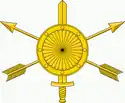 |
| Russian Armed Forces |
|---|
.svg.png.webp) |
| Staff |
| Services (vid) |
| Independent troops (rod) |
| Special operations force (sof) |
| Other troops |
| Military districts |
| History of the Russian military |
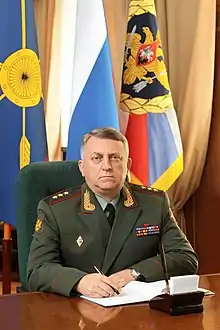
The Strategic Rocket Forces of the Russian Federation or the Strategic Missile Forces of the Russian Federation (RVSN RF; Russian: Ракетные войска стратегического назначения Российской Федерации (РВСН РФ), romanized: Raketnye voyska strategicheskogo naznacheniya Rossiyskoy Federatsii, lit. 'Strategic Purpose Rocketry Troops of the Russian Federation') is a separate-troops branch of the Russian Armed Forces that controls Russia's land-based intercontinental ballistic missiles (ICBMs). It was formerly part of the Soviet Armed Forces from 1959 to 1991.
The Strategic Rocket Forces was created on 17 December 1959 as part of the Soviet Armed Forces as the main force for operating all Soviet nuclear ground-based intercontinental, intermediate-range ballistic missile, and medium-range ballistic missile with ranges over 1,000 kilometers. After the Soviet Union collapsed in 1991, assets of the Strategic Rocket Forces were in the territories of several new states in addition to Russia, with armed nuclear missile silos in Belarus, Kazakhstan and Ukraine. The three of them transferred their missiles to Russia for dismantling and they all joined the Nuclear Non-Proliferation Treaty.
Complementary strategic forces within Russia include the Russian Aerospace Forces' Long Range Aviation and the Russian Navy's ballistic missile submarines. Together the three bodies form Russia's nuclear triad.
History
The first Soviet rocket study unit was established in June 1946, by redesignating the 92nd Guards Mortar Regiment at Bad Berka in East Germany as the 22nd Brigade for Special Use of the Reserve of the Supreme High Command.[3] On October 18, 1947, the brigade conducted the first launch of the remanufactured former German A-4 ballistic missile, or R-1, from the Kapustin Yar Range.[4] In the early 1950s the 77th and 90th Brigades were formed to operate the R-1 (SS-1a 'Scunner'). The 54th and 56th Brigades were formed to conduct test launches of the R-2 (SS-2 'Sibling') at Kapustin Yar on June 1, 1952.
The 5th Scientific Research Proving Ground was established in 1955 in Kzyl-Orda Oblast at the town of Zarya later Leninsk, and finally in 1995 Baikonur.[5] Also established that year was the 43rd Independent Scientific Experimental Station (Klyuchi, Kamchatka Krai) as an outstation of the Baikonur test site. Two years later "Object Angara" was formed at Plesetsk, Arkhangelsk Oblast, which after another name change in 1959 eventually became the 53rd Scientific Research Proving Ground in 1963.[6]
From 1959 the Soviets introduced a number of intercontinental ballistic missiles (ICBMs) into service, including the R-12 (SS-4 'Sandal'), the R-7 (SS-6 'Sapwood'), the R-16 (SS-7 'Saddler'), the R-9 (SS-8 'Sasin'), the R-26 (given the NATO reporting name SS-8 'Sasin' due to incorrect identification as the R-9), the R-36 (SS-9 'Scarp'), and the RT-21 (SS-16 'Sinner'), which was possibly never made fully operational.
By 1990 all early types of missiles had been retired from service. In 1990 the Strategic Missile Forces were officially established as a service branch of the Armed Forces under the direct control of the Defense Ministry. The date of its formal foundation, December 17, is celebrated as Strategic Missile Forces Day.
Two rocket armies were formed in 1960. The 43rd Rocket Army and the 50th Rocket Army were formed from the previous 43rd and 50th Air Armies of the Long Range Aviation.
During a test of the R-16 ICBM on October 24, 1960, the test missile exploded on the pad, killing the first commander of the SRF, Chief Marshal of Artillery Mitrofan Ivanovich Nedelin. This disaster, the details of which were concealed for decades, became known as the Nedelin catastrophe. He was succeeded by Marshal of the Soviet Union Kirill Moskalenko who was in turn quickly succeeded by Marshal Sergey Biryuzov.[7] Under Marshal Вiryuzov the SRF deployed missiles to Cuba in 1962 as part of Operation Anadyr. 36 R-12 intermediate range ballistic missiles were sent to Cuba, initiating the Cuban Missile Crisis. The 43rd Guards Missile Division of 43rd Rocket Army manned the missiles while in Cuba.[8]
Marshal Nikolai Krylov took over in March 1963 and served until February 1972. During this time French President Charles de Gaulle visited the Strategic Missile Forces in 1966. Together with NI Krylov, he visited a missile division in Novosibirsk, and then at the invitation of Leonid Brezhnev participated in a demonstration missile launch at the Baikonur Cosmodrome in the Kazakh SSR. Chief Marshal of Artillery Vladimir Fedorovich Tolubko commanded the SRF from April 12, 1972, to July 10, 1985. Tolubko emphasised raising the physical fitness standards within the SRF and in the late 1970s and early 1980s, the Strategic Rocket Forces began to field the new UR-100 (SS-11 'Sego') and UR-100N (SS-19 'Stilleto') ICBMs beginning with the 43rd Rocket Army in the Ukrainian SSR, providing them with longer range and more accurate missiles. He was succeeded by General of the Army Yury Pavlovich Maksimov, who was in command from July 10, 1985, to August 19, 1992.
According to a 1980 TIME Magazine article citing analysts from RAND Corporation, Soviet non-Slavs were generally barred from joining the Strategic Missile Forces because of suspicions about the loyalty of ethnic minorities to the state.[9] Those who served in the Strategic Rocket Forces had better quality of living, food and also higher salaries than the ones paid to those serving in the Soviet Army. The majority of new recruits has, since its inception, consisted of mainly college and university graduates.
In 1989 the Strategic Missile Forces had over 1,400 ICBMs, 300 launch control centers, and twenty-eight missile bases.[10] The SMT operated RSD-10 (SS-20 'Saber') intermediate-range ballistic missiles (IRBMs) and R-12 (SS-4 'Sandal') medium-range ballistic missiles (MRBMs). Two-thirds of the road-mobile Soviet RSD-10 force was based in the western Soviet Union and was aimed at Western Europe.
One-third of the force was located east of the Ural Mountains and was targeted primarily against China. Older R-12 missiles were deployed at fixed sites in the western Soviet Union. The Intermediate-Range Nuclear Forces Treaty, signed in December 1987, called for the elimination of all 553 Soviet RSD-10 and R-12 missiles within three years. As of mid-1989, over 50% of RSD-10 and R-12 missiles had been eliminated.
By 1990 the Soviet Union had seven types of operational ICBMs. About 50% were heavy R-36M (SS-18 'Satan') and UR-100N (SS-19 'Stiletto') ICBMs, which carried 80% of the country's land-based ICBM warheads. By this time it was producing new mobile, and hence survivable ICBMs, the RT-23 (SS-24 'Scalpel') and RT-2PM (SS-25 'Sickle').[11]
In 1990, with the R-12 apparently fully retired, the IISS reported that there were 350 UR-100s (SS-11 'Sego,' Mod 2/3), 60 RT-2s (SS-13 'Savage') still in service in one missile field, 75 UR-100MRs (SS-17 'Spanker,' Mod 3, with 4 MIRV), 308 R-36Ms (mostly Mod 4 with 10 MIRV), 320 UR-100Ns (mostly Mod 3 with 6 MIRV), some 60 RT-23s (silo and rail-mobile), and some 225 RT-2PMs (mobile).[11]
Composition of the Strategic Missile Forces 1960–1991[12]
| Formation | Headquarters Location | Year formed as Corps | Year formed as Army | Year disbanded[7] | Divisions |
|---|---|---|---|---|---|
| 27th Guards Rocket Army | HQ Vladimir, Moscow Military District | Sept. 1, 1959 | 1970 | Still active | 7th Guards Rocket Division, 28th Guards Rocket Division, (32 [13]), 54th Guards Rocket Division, 60th Rocket Division |
| 31st Rocket Army | Orenburg, Urals Military District | Sept. 5, 1965 | 1970 | Still active | 8th, 13th, 14th, (41st Guards), 42nd, 50, 52nd, (55), 59 |
| 33rd Guards Rocket Army | Omsk, Siberian Military District | 1962 | 1970 | Still active | 23, (34), 35th, 36th Guards, 38, 39th Guards, 57, 62 |
| 43rd Rocket Army[14] | Vinnitsa, Kiev Military District | — | 1960 | May 8, 1996 | 19 (Khmelnitsky), 37th Guards (Lutsk), 43 (Kremenchug), 44 (Kolomyia, Ivano-Frankovsk Oblast, disbanded March 1990; 46 (Pervomaisk, Mykolaiv Oblast) |
| 50th Rocket Army | Smolensk, Belorussian Military District | — | 1960 | June 30, 1990 | 1988:[7] 7th Guards, 24th Guards (Gvardeysk, Kaliningrad Oblast),[15] 31st Guards (former 83rd Guards Bryansko-Berlinskaya Aviation (Missile) Division, renumbered July 1, 1960), 32nd (Postavy, Vitebsk Oblast), 40th, 49th Guards (Lida, Grodno Region, 1963 to 1990), 58th (Karmelava, Lithuania) |
| 53rd Rocket Army[16] | Chita, Transbaikal Military District | 1962 | June 8, 1970 | Sept. 16, 2002 | 1988:[7] 4th Rocket Division (Drovyanaya, Chita Oblast), 23rd Guards Rocket Division (Kansk, assigned 1983–2002), 27th Rocket Division (Svobodnyy, Amur Oblast), 29th, 36th Guards, 47th Rocket Division (Olovyannaya, Chita Oblast)[17] |
RSVN training establishments included:[18]
- the Peter the Great Military Academy of the Strategic Missile Forces in Moscow;
- the Military Engineering Red Banner Institute imeni A.F. Mozhayskiy (VIKI) in Leningrad;
- the Kharkov Higher Military Command Engineering School Missile Forces imeni Marshal of the Soviet Union N.I. Krylov
- the Krasnodar Higher Military Command Engineering School Missile Forces (KVVKIU) (1982-1998)
- the Perm Higher Military Command Engineering Red Banner School Missile Forces (ru:Пермский военный институт ракетных войск)
- the Riga Higher Military Political Red Banner School imeni Marshal of the Soviet Union S.S. Biryuzov (under the SRF from 1959-1993)
- the Rostov Higher Military Command Engineering School Missile Forces (RVVKIU) (1959 onwards)
- the Saratov Higher Military Command Engineering Red Banner order of the Red Star School Missile Forces imeni Major-General A.I. Lizyukov (SVVKIU) (1959-2003)
- the Serpukhov Higher Military Command Engineering School Missile Forces imeni Leninskiy Komsomol (SVVKU)
Post Soviet Union
Like most of the Russian Armed Forces, the Strategic Missile Forces had limited access to resources for new equipment in the Yeltsin era. However, the Russian government made a priority of ensuring that the Missile Forces received new missiles to phase out older, less-reliable systems, and to incorporate newer capabilities in the face of international threats to the viability of the nuclear deterrent effect provided by their missiles. In particular the development of missile defense systems in the United States.
In 1995, the "Strategic Missile Forces Day" and "Military Space Forces Day" were created. On July 16, 1997, President Boris Yeltsin signed a decree incorporating the Russian Space Forces and the Space Missile Defence Forces (Russian: Ракетно-космической обороны) into the SMT.[19] In doing so, 'nearly 60' military units and establishments were dissolved. However, four years later, on June 1, 2001, the Russian Space Forces were reformed as a separate branch of service from the SMT.
Minister of Defence Marshal of the Russian Federation Igor Sergeev, a former commander of the SMT from August 19, 1992 – May 22, 1997, played a major role in assuring funding for his former service.[7] He was succeeded by General of the Army Vladimir Yakovlev, who commanded the SMT from June 1997 until April 27, 2001. Yakovlev was succeeded by Colonel General Nikolay Solovtsov.
Solovtsov was dismissed in July–August 2009. Speculation over why Solovtsov was dismissed included opposition to further cuts in deployed nuclear ballistic missile warheads below the April 2009 figure of 1,500, the fact that he had reached the retirement age of 60, despite that he had recently been extended another year's service, or the failure of the Navy's Bulava missile).
After only a year, Lieutenant General Andrey Shvaichenko, appointed on August 3, 2009, by President Dmitry Medvedev, was replaced. The current commander of the Strategic Missile Forces, Colonel General Sergei Karakayev, was appointed to the post by a presidential decree of June 22, 2010.[20][21]
The RVSN headquarters has a special sledgehammer that can be used to gain access to the launch codes if the commander feels the need to use it or if ordered directly, but doesn't have normal access to the safe. In 2020, the Strategic Missile Forces completed switching to digital information transmission technology.[22]
Composition since 2010s

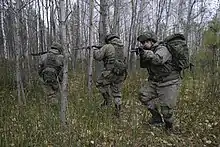
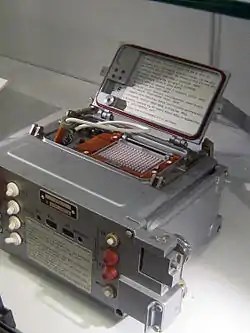
The main RVSN command post is at Kuntsevo in the suburbs of Moscow. The alternate command post is at Kosvinsky Mountain in the Urals.[23]
Female cadets have started to join the Peter the Great Strategic Missile Forces Academy. In the past, only men were allowed to serve in the Missile Forces. RVSN institutes also exist at Serpukhov and Rostov-on-Don. An ICBM test impact range is located in the Far East, the Kura Test Range. This has been under Aerospace Defence Forces' command since 2010.
The Strategic Missile Forces operate four distinct missile systems. The oldest system is the silo-based R-36M2 / SS-18 Satan. It carries ten warheads. The last missile will be in service until 2020.[24][25]
The second system is the silo-based UR-100NUTTH / SS-19 Stiletto. The last Stiletto missiles in service with six warheads each will be removed by 2019. The third system, the single warhead mobile RT-2PM Topol / SS-25 Sickle was decommissioned by 2023.[26][25][27]
A new missile entering service is the RT-2UTTH Topol-M / SS-27 Sickle B with single warhead, of which 60 are silo-based and 18 are mobile. Some new missiles will be added in the future. The first upgraded Topol-M called RS-24 Yars, carrying three warheads, was commissioned in 2010. In July 2011 the first mobile regiment with nine missiles was completed.[28] From 2012 to 2017, about 80 ICBMs were placed in active duty.[29][30] The RF Defense Minister said in December 2022 that 91.3% of the country's nuclear forces was modern.[31][32][33] 3 missile regiments rearmed in 2023.[34][35]
Units
The composition of missiles and warheads of the Strategic Missile Forces previously had to be revealed as part of the START I treaty data exchange. The most recently reported (January 2020) order of battle of the forces was as follows:[36]
- 27th Guards Rocket Army (Military Unit No. 43176) (HQ: Vladimir) [37]
- 98th Mixed Aviation Squadron
- 7th Guards Rocket Division (Military Unit No. 14245)[38] at Vypolzovo with 18+ mobile RS-24 Yars[39][40]
- 14th Rocket Division (Military Unit No. 34096)[41] at Yoshkar-Ola with 27 mobile RS-24 Yars
- 28th Guards Rocket Division (Military Unit No. 54055)[42] at Kozelsk with 19 (December 2023)[43][44][45] silo-based RS-24[46][47]
- 54th Guards Rocket Division (Military Unit No. 34048)[48] at Teykovo with 18 mobile RT-2UTTH Topol-M and 18 (December 2011)[49] mobile RS-24
- 60th Rocket Division (Military Unit No. 89553)[50] at Tatischevo with 30 silo-based UR-100NUTTH and 60 silo-based RT-2UTTH Topol-M
- 31st Rocket Army (HQ: Orenburg)
- 102nd Mixed Aviation Squadron
- 8th Rocket Division at Pervomaysky, Kirov Oblast
- 13th Red Banner Rocket Division at Dombarovskiy with 18 silo-based R-36M2 and 11 (December 2023) UR-100NUTTH with Avangard (hypersonic glide vehicle)s (Project 4202).[51][52][53][54][55] The R-36s will be replaced with the new RS-28 Sarmat when operational.[56]
- 42nd Rocket Division at Nizhniy Tagil with 27 mobile RS-24 Yars
- 33rd Guards Rocket Army (HQ: Omsk)
- 105th Mixed Aviation Squadron
- 29th Guards Rocket Division at Irkutsk with 27 mobile RS-24 Yars
- 35th Rocket Division at Barnaul with mobile RT-2PM Topol and[57] RS-24 Yars
- 39th Guards Rocket Division at Novosibirsk with 27 mobile RS-24 Yars
- 62nd Rocket Division at Uzhur with 28 silo-based R-36M2, which will also be replaced with the new RS-28 Sarmat when operational.[56]
Numbers of missiles and warheads
The Strategic Missile Forces have:[36]
- 46 silo-based R-36M2 (SS-18) with up to 10 warheads, to be retired 2022
- 45 mobile RT-2PM "Topol" (SS-25) with 1 warhead, now retired
- 60 silo-based RT-2UTTH "Topol M" (SS-27) with 1 warhead
- 18 mobile RT-2UTTH "Topol M" (SS-27) with 1 warhead
- 19 silo-based RS-24 "Yars" (SS-29) with up to 4 warheads
- 135+ mobile RS-24 "Yars" (SS-29) with up to 4 warheads
Kristensen and Korda (2020) list the UR-100N (SS-19), as retired from deployment, while noting that UR-100NUTTH being deployed with the Avangard.[58]
Weapons and equipment
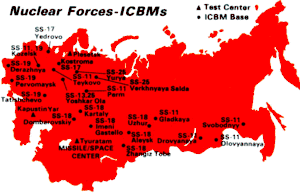
Medium-range ballistic missiles
- R-12 Dvina, SS-4 Sandel – In service from 1959 to 1993.
Intermediate-range ballistic missiles
- R-14 Chusovaya, SS-5 Skean – In service from 1962 to 1984.
- RSD-10 Pioneer, SS-20 Sabre, SS-23 Sabre 2 – In service from 1976 to 1988.
Intercontinental-range ballistic missiles
- MR-UR-100 Sotka, SS-17 Spanker – In service from 1975 to 1995.
- R-7 Semyorka, SS-6 Sapwood – In service from 1959 to 1968.
- R-9 Desna, SS-8 Sasin – In service from 1964 to 1976.
- R-16, SS-7 Saddler – In service from 1961 to 1976.
- RT-2, SS-13 Savage – In service from 1968 to 1976.
- RT-20P, SS-15 Scrooge – In service from 1961 to 1962.
- RT-21 Temp 2S, SS-16 Sinner – In service from 1976 to 1986.
- RT-23 Molodets, SS-24 Scalpel – In service from 1987 to 2005.
- UR-100, SS-11 Sego – In service from 1967 to 1974.
- UR-200, SS-10 Scrag – In service from 1963 to 1964.
Ranks and rank insignia
- Officer ranks
| Rank group | General / flag officers | Senior officers | Junior officers | Officer cadet | ||||||||||||||||||||||||||||||||
|---|---|---|---|---|---|---|---|---|---|---|---|---|---|---|---|---|---|---|---|---|---|---|---|---|---|---|---|---|---|---|---|---|---|---|---|---|
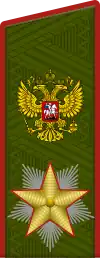 |
 |
 |
 |
 |
 |
 |
 |
 |
 |
 |
 |
-2010.svg.png.webp) | ||||||||||||||||||||||||
| Marshal of the Russian Federation Ма́ршал Росси́йской Федера́ции |
Army general генера́л а́рмии |
Colonel general генера́л-полко́вник |
Lieutenant general генера́л-лейтена́нт |
Major general генера́л-майо́р |
Colonel полко́вник |
Lieutenant colonel подполко́вник |
Major майо́р |
Captain капита́н |
Senior lieutenant ста́рший лейтена́нт |
Lieutenant лейтена́нт |
Junior lieutenant мла́дший лейтена́нт |
Cadet Курсант | ||||||||||||||||||||||||
- Other ranks
| Rank group | General / flag officers | Senior officers | Junior officers | Officer cadet | ||||||||||||||||||||||||||||||||
|---|---|---|---|---|---|---|---|---|---|---|---|---|---|---|---|---|---|---|---|---|---|---|---|---|---|---|---|---|---|---|---|---|---|---|---|---|
 |
 |
 |
 |
 |
 |
 |
 | |||||||||||||||||||||||||||||
| Senior warrant officer Ста́рший пра́порщик |
Warrant officer Пра́порщик |
Master sergeant Старшина́ |
Senior sergeant Ста́рший сержа́нт |
Sergeant Сержа́нт |
Junior sergeant Мла́дший сержа́нт |
Corporal Ефре́йтор |
Private Рядово́й | |||||||||||||||||||||||||||||
Future
According to the Federation of American Scientists, for the foreseeable future, all new Russian ICBM deployments will be of MIRVed versions of the SS-27 "Topol-M". A “new ICBM” and a “heavy ICBM” are also being developed. By the early 2020s, according to announcements by Russian military officials, all SS-18 and SS-25 ICBMs will be retired from service following the retirements of the SS-19 systems.
This development would leave a Russian ICBM force structure based on five modifications of the solid-fuel SS-27 (silo- and mobile-based SS-27 Mod 1 (Topol-M); silo- and mobile-based SS-27 Mod 2 (RS-24 Yars); and the RS-26 Rubezh) and the liquid-fuel RS-28 Sarmat with a large payload – either MIRV or some advanced payload to evade missile defense systems. Although the future force will be smaller, a greater portion of it will be MIRVed – up from approximately 36 percent in 2014 to roughly 70 percent by 2024.
See also
References
- ↑ https://fas.org/sgp/crs/row/IF11603.pdf
- ↑ Main Cathedral of Russian Armed Forces. Archived February 2, 2019, at the Wayback Machine Retrieved 2019-02-02.
- ↑ Michael Holm, 24th Guards Rocket Division Archived September 28, 2011, at the Wayback Machine, accessed December 2013.
- ↑ "RVSN – Strategic Missile Forces – Russian and Soviet Nuclear Forces". fas.org. Archived from the original on July 10, 2017. Retrieved April 2, 2018.
- ↑ "5th Scientific Research Proving Ground".
- ↑ http://www.ww2.dk/new/rvsn/53niip.htm
- 1 2 3 4 5 Mike Holm, Strategic Missile Forces Archived December 1, 2010, at the Wayback Machine
- ↑ National Security Archive, http://www.gwu.edu/~nsarchiv/NSAEBB/NSAEBB14/doc18.htm Archived August 8, 2010, at the Wayback Machine
- ↑ [The U.S.S.R.: Moscow's Military Machine The U.S.S.R.: Moscow's Military Machine], TIME Magazine, June 23, 1980
- ↑ Library of Congress Soviet Union Country Study Archived October 18, 2015, at the Wayback Machine, 1989
- 1 2 IISS Military Balance 1990–91, p.34
- ↑ Feskov, V.I.; Kalashnikov, K.A.; Golikov, V.I. (2004). The Soviet Army in the Years of the Cold War 1945–91. Tomsk: Tomsk University Publishing House. p. 132. ISBN 5-7511-1819-7.
- ↑ "32nd Missile Division". Ww2.dk. Archived from the original on September 28, 2011. Retrieved October 9, 2012.
- ↑ "Ukraine: Foreign Assistance:The CTR Program in Ukraine". www.nti.org. Archived from the original on November 11, 2010.
- ↑ Previously 92 BON, then given the combined-arms designation of 22nd RVGK special-purpose brigade, then 72nd RVGK Engineer Brigade, and in 1960 the 24th Guards Division of the RVSN was formed on its basis. http://www.ww2.dk/new/rvsn/24gvmd.htm Archived September 28, 2011, at the Wayback Machine
- ↑ Formed Chita in 1970 from the 8th Independent Missile Corps, under Colonel-General Yury Zabegaylov. Included 45th Rocket Division (disbanded 1970).
- ↑ http://www.ww2.dk/new/rvsn/47md.htm Archived September 28, 2011, at the Wayback Machine 47th Missile Division
- ↑ Michael Holm, RSVN Schools
- ↑ Greg Austin and Alexiy D. Muraviev, The Armed Forces of Russia in Asia, Tauris, 2001, p.185-6
- ↑ Pavel Podvig, Russian Strategic Missile Forces Archived May 14, 2011, at the Wayback Machine, accessed September 2010
- ↑ Указ Президента Российской Федерации от 09.08.2012 № 1141 "О присвоении воинских званий высших офицеров военнослужащим Вооруженных Сил Российской Федерации" [Decree of the President of the Russian Federation dated 09.08.2012 number 1141 "About the assignment of ranks of senior officers of the Armed Forces of the Russian Federation"] (in Russian). Kremlin.ru. August 9, 2012. Archived from the original on November 5, 2013. Retrieved August 14, 2012.
- ↑ "ЦАМТО / / В 2020 году РВСН полностью перешли на цифровые технологии передачи информации".
- ↑ Jane's Defence Weekly June 25, 1994, 32, via Austin and Muraviev, The Armed Forces of Russia in Asia, 2001.
- ↑ Topol might stay in service until 2019 (October 28, 2011). "Topol might stay in service until 2019 - Blog - Russian strategic nuclear forces". Russian Strategic Nuclear Forces. Russianforces.org. Archived from the original on February 3, 2012. Retrieved October 9, 2012.
{{cite journal}}: CS1 maint: numeric names: authors list (link) - 1 2 Launch of Topol to confirm missile life extension (November 3, 2011). "Launch of Topol to confirm missile life extension - Blog - Russian strategic nuclear forces". Russian Strategic Nuclear Forces. Russianforces.org. Archived from the original on February 3, 2012. Retrieved October 9, 2012.
- ↑ Topol might stay in service until 2019 (October 28, 2011). "Topol might stay in service until 2019 - Blog - Russian strategic nuclear forces". Russian Strategic Nuclear Forces. Russianforces.org. Archived from the original on February 3, 2012. Retrieved October 9, 2012.
{{cite journal}}: CS1 maint: numeric names: authors list (link) - ↑ Новости, Р. И. А. (December 16, 2023). "Мобильную группировку РВСН полностью перевооружили на комплекс "Ярс"". РИА Новости (in Russian). Retrieved January 14, 2024.
- ↑ Deployment of the first full regiment of RS-24 is completed (July 7, 2011). "Deployment of the first full regiment of RS-24 is completed - Blog - Russian strategic nuclear forces". Russian Strategic Nuclear Forces. Russianforces.org. Archived from the original on August 6, 2011. Retrieved October 9, 2012.
{{cite journal}}: CS1 maint: numeric names: authors list (link) - ↑ Path, Neal (June 5, 2020). "Russia sets up ballistic missile early warning satellite grouping to monitor the US". International Insider. Retrieved June 5, 2020.
- ↑ "Remarks by Chief of General Staff of the Russian Federation General of the Army Valery Gerasimov at the Russian Defence Ministry's board session (November 7, 2017) : Ministry of Defence of the Russian Federation". eng.mil.ru. Archived from the original on November 9, 2017. Retrieved April 2, 2018.
- ↑ "Shoigu speaks about Russian army's breakthrough at educational marathon New Knowledge".
- ↑ "Russian nuclear trifecta modernization level highest in history, defense minister says".
- ↑ "ЦАМТО / / Сергей Шойгу подвел итоги деятельности ВС РФ в 2022 году и определил задачи на очередной период".
- ↑ "Russian Strategic Missile Forces raise proportion of new-generation missile systems to 88%". tass.com. Retrieved December 19, 2023.
- ↑ "Another missile regiment goes on combat duty in Russia — Strategic Missile Forces chief". tass.com. Retrieved December 19, 2023.
- 1 2 Podvig, Pavel (December 13, 2007). "Strategic Missile Forces". Russian Strategic Nuclear Forces. Archived from the original on April 1, 2018. Retrieved April 2, 2018.
- ↑ "27-я гвардейская ракетная Витебская Краснознаменная армия (в/ч 43176)". rvsn.info (in Russian). Retrieved July 27, 2023.
- ↑ "7-я гвардейская ракетная Режицкая Краснознаменная дивизия (в/ч 14245)". rvsn.info. Retrieved July 27, 2023.
- ↑ "МО РФ показало кадры заступления на боевое дежурство полка мобильных "Ярсов" в Бологом".
- ↑ "Missile unit in Tver Region enters combat duty with Yars ICBM system — missile force chief".
- ↑ "14-я ракетная Киевско-Житомирская ордена Кутузова дивизия (в/ч 34096)". rvsn.info. Retrieved July 27, 2023.
- ↑ "28-я гвардейская ракетная Краснознаменная дивизия (в/ч 54055)". rvsn.info. Retrieved July 27, 2023.
- ↑ Podvig, Pavel (October 13, 2020). "Two Yars missiles deployed in Kozelsk". Russian Strategic Nuclear Forces.
- ↑ "Rearmament of Kozelsk missile division continues".
- ↑ "Next Yars ICBM placed into silo in strategic missile formation in central Russia".
- ↑ "ЦАМТО / / МБР «Ярс» загрузили в шахту в Козельском ракетном соединении". ЦАМТО / Центр анализа мировой торговли оружием (in Russian). November 22, 2023. Retrieved December 19, 2023.
- ↑ "ЦАМТО / / В Козельском соединении РВСН стратегические ракетчики загрузили МБР «Ярс» в шахтную пусковую установку". ЦАМТО / Центр анализа мировой торговли оружием (in Russian). December 18, 2023. Retrieved December 19, 2023.
- ↑ "54-я гвардейская ракетная ордена Кутузова дивизия (в/ч 34048)". rvsn.info. Retrieved July 27, 2023.
- ↑ RS-24 deployment in Teykovo, Novosibirsk, and Kozelsk (December 19, 2011). "RS-24 deployment in Teykovo, Novosibirsk, and Kozelsk - Blog - Russian strategic nuclear forces". Russian Strategic Nuclear Forces. Russianforces.org. Archived from the original on January 26, 2012. Retrieved October 9, 2012.
{{cite journal}}: CS1 maint: multiple names: authors list (link) CS1 maint: numeric names: authors list (link) - ↑ "60-я ракетная Таманская ордена Октябрьской Революции Краснознамённая дивизия имени 60-летия СССР (в/ч 89553)". rvsn.info. Retrieved July 27, 2023.
- ↑ Podvig, Pavel (August 26, 2014). "Russian hypersonic vehicle - more dots added to Project 4202". Russian Strategic Nuclear Forces. russianforces.org. Archived from the original on March 15, 2015. Retrieved January 18, 2015.
- ↑ "Подробнее : Министерство обороны Российской Федерации".
- ↑ "Missile regiment near Orenburg being rearmed with Avangard system — Defense Ministry".
- ↑ "Avangard missiles put on combat duty in Russia's southern Urals".
- ↑ "ЦАМТО / / В Оренбургской области завершены работы по перевооружению очередного полка соединения РВСН на РК «Авангард»". ЦАМТО / Центр анализа мировой торговли оружием (in Russian). December 18, 2023. Retrieved December 19, 2023.
- 1 2 "Sarmatian ICBM & FOBS Reintroduction". globalsecurity.org. Archived from the original on April 6, 2017. Retrieved April 6, 2017.
- ↑ "Минобороны раскрыло характеристики ракетного комплекса "Ярс-С"". January 29, 2021.
- ↑ Hans M. Kristensen & Matt Korda (2020) Russian nuclear forces, 2020, Bulletin of the Atomic Scientists, 76:2, 102-117, DOI: 10.1080/00963402.2020.1728985
Further reading
- Дороговоз И. Г. Ракетные войска СССР. — Минск: Харвест, 2007. — 336 с. — ISBN 978-985-13-9751-4
- John G. Hines et al. Soviet Intentions 1965–1985. Braddock Dunn & McDonald (BDM), 1995.
- Strategic Missile Forces museum Archived March 10, 2012, at the Wayback Machine
- Main, Dr Steven J. (August 2002). The Strategic Rocket Forces 1991-2002 (PDF). Conflict Studies Research Centre.
- "Владимирская Ракетная Стратегическая" (Vladimirskaya Strategic Missile) by I.V. Vershkov and V.G. Gagarin; Vladimir 2006; 480 pages;
- "Оренбургская Стратегическая" (Orenburg Strategic) by Y.N. Feoktistov; Perm 2001; 328 pages; (also a 1997 edition).
- "Читинская Ракетная Армия" (Chitinskaya Missile Army) by ??; Chita, 2002; 268 pages
- "История 50-й Ракетной Армии I-IV" (History 50th Missile Army, part 1–4) by G.I. Smirnov and A.I. Yasakov; Smolensk 2008; 370+342+387+561 pages
- "Стратеги" (Strategic) by V.T. Nosov; Moscow, 2008; 276 pages;